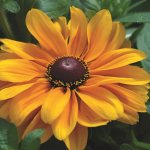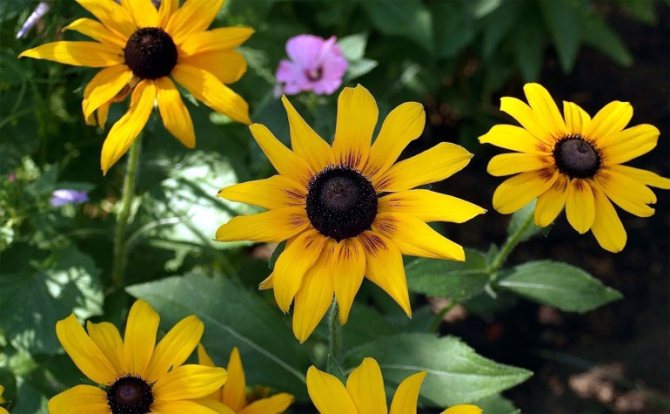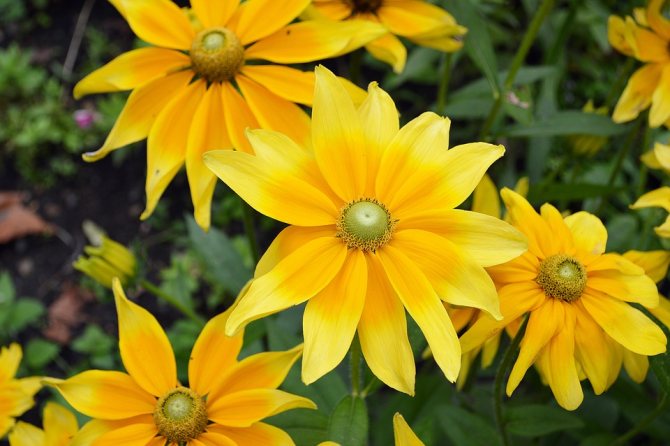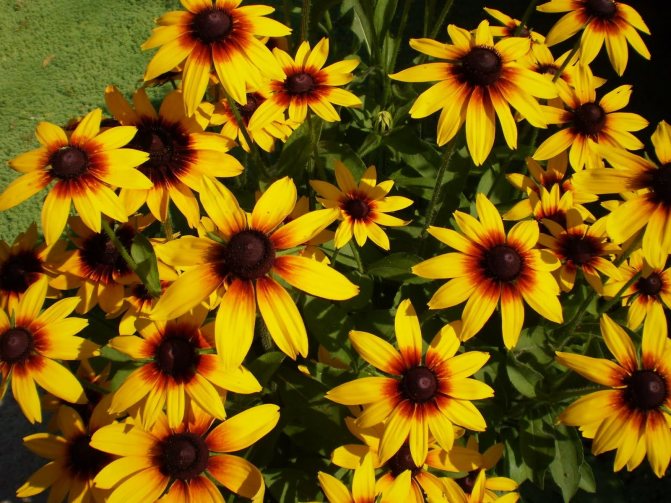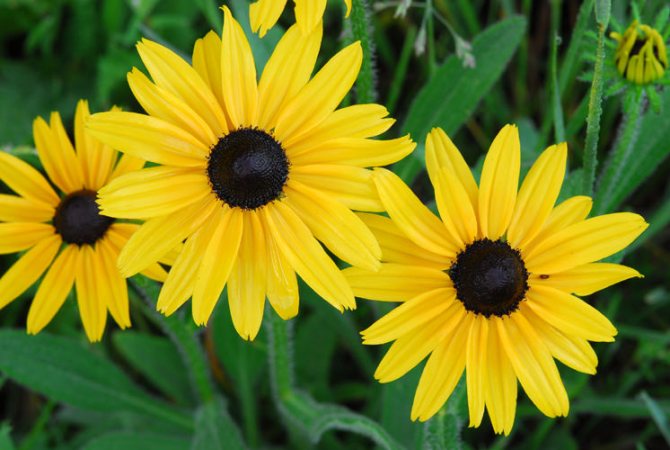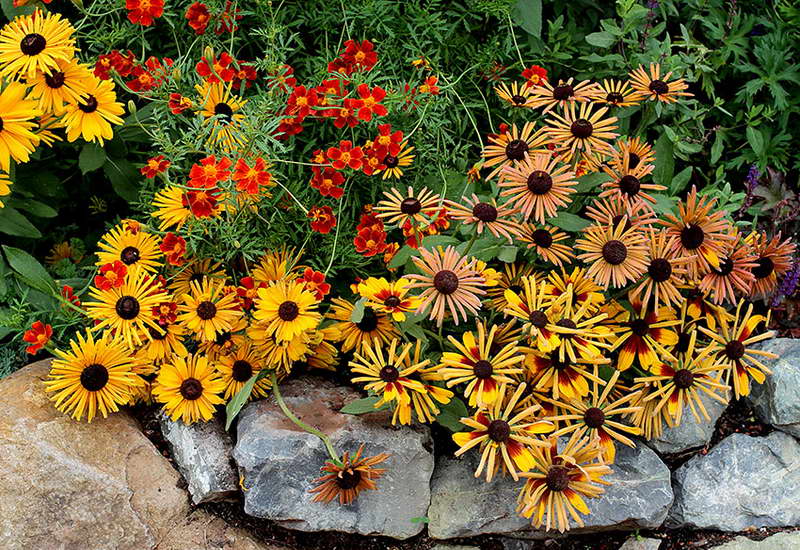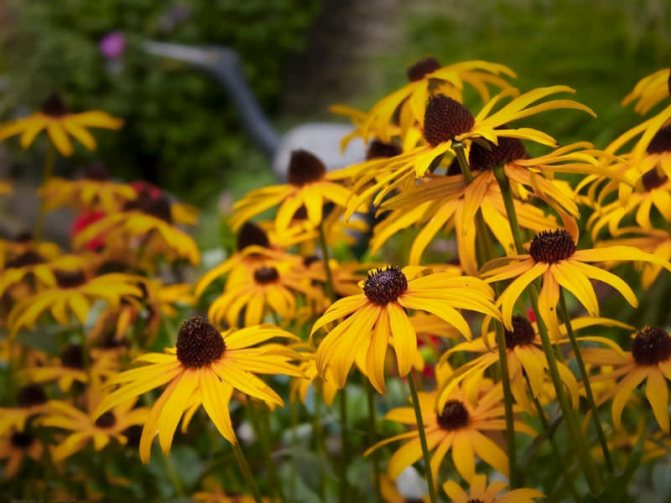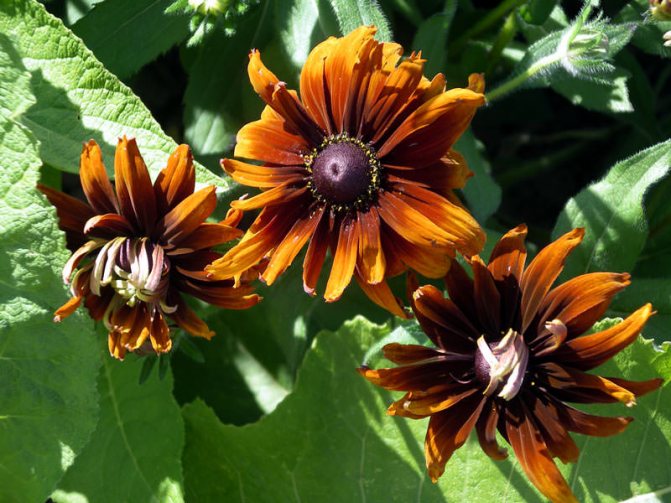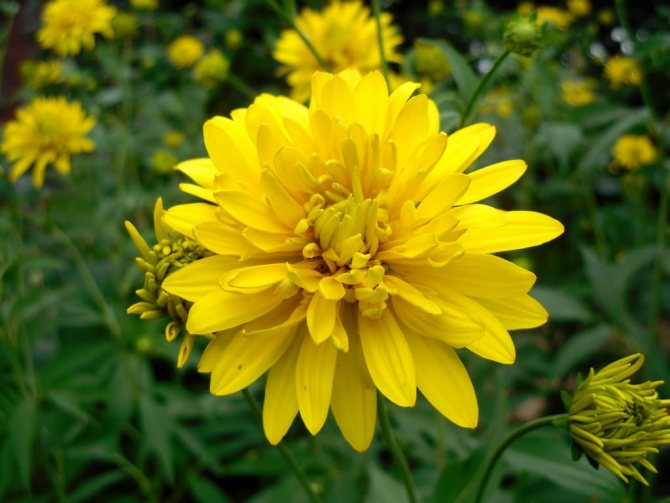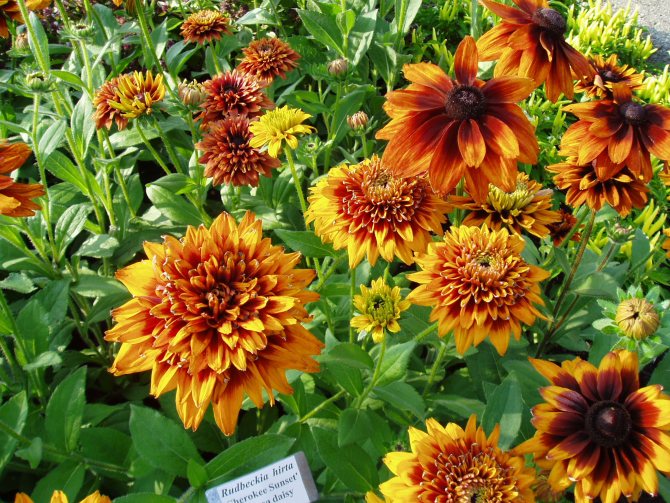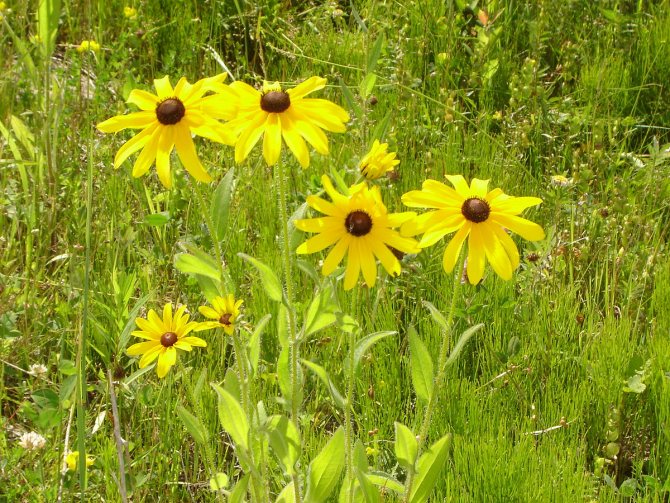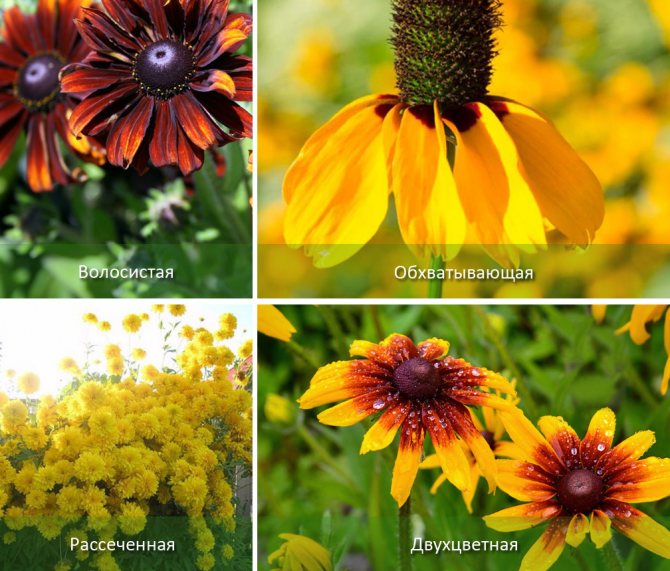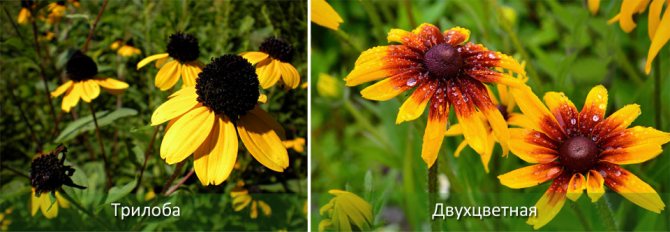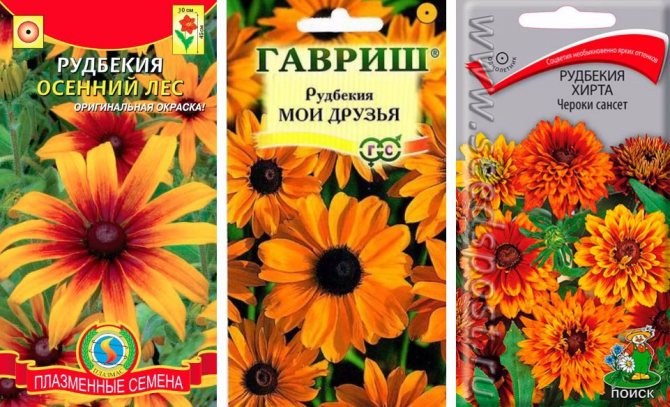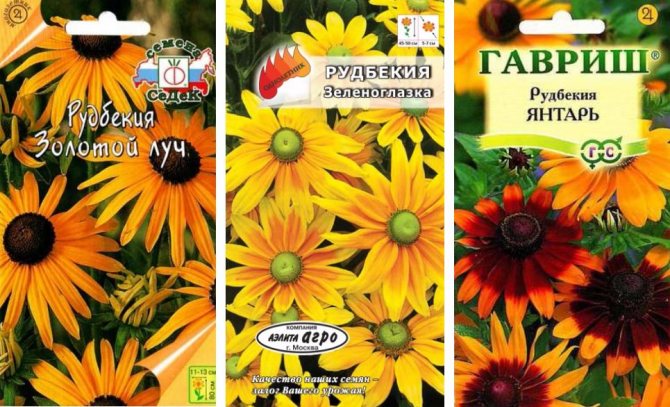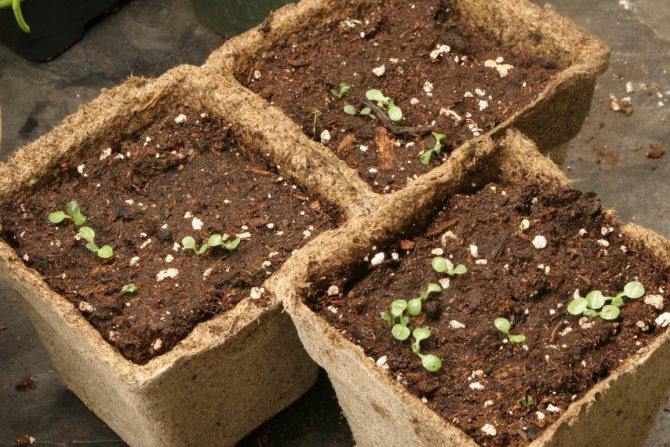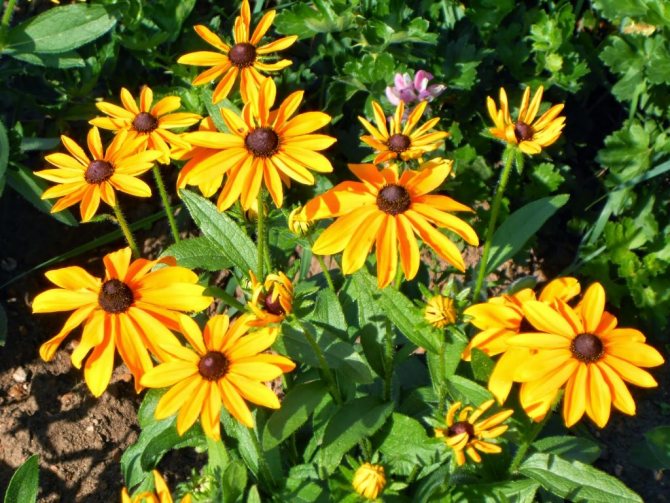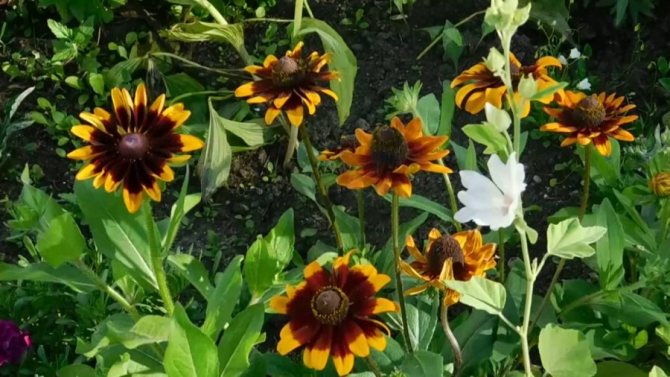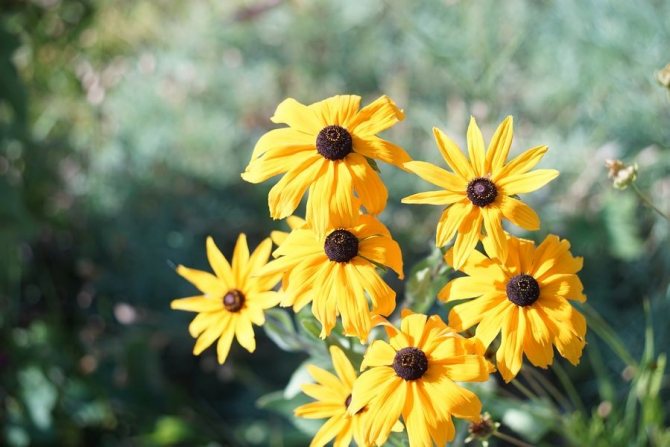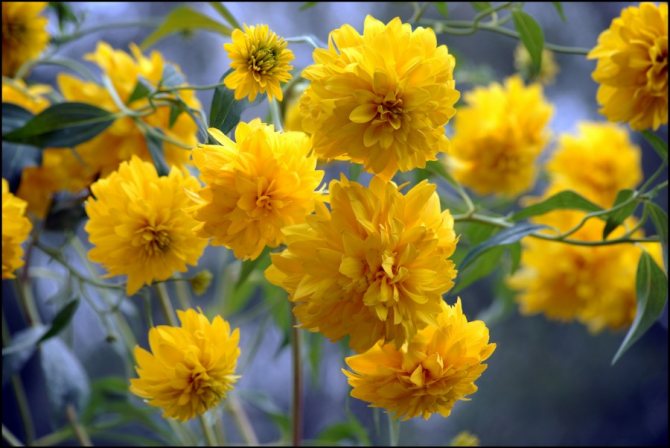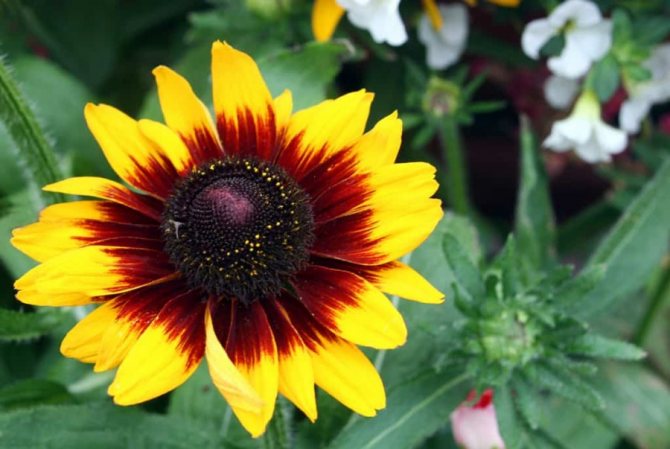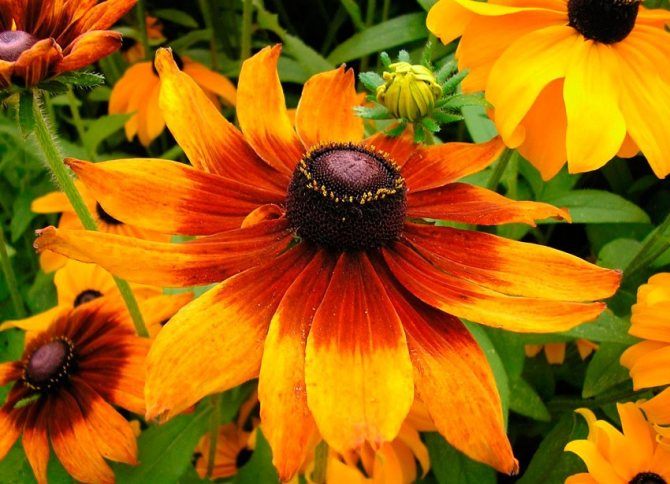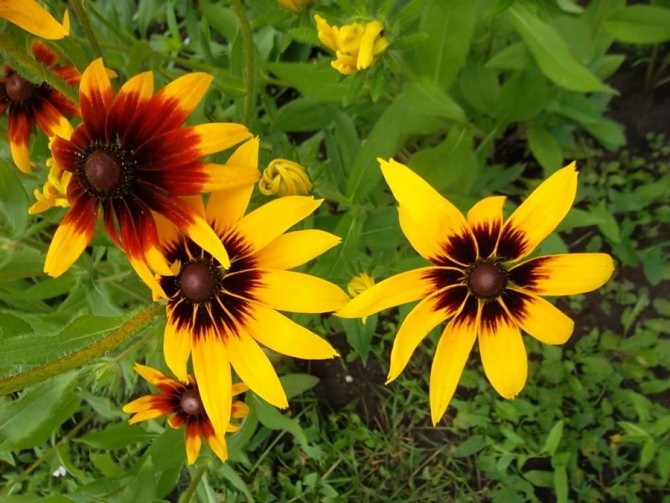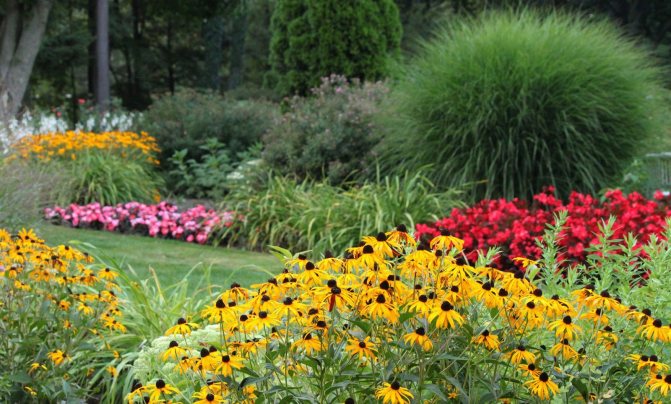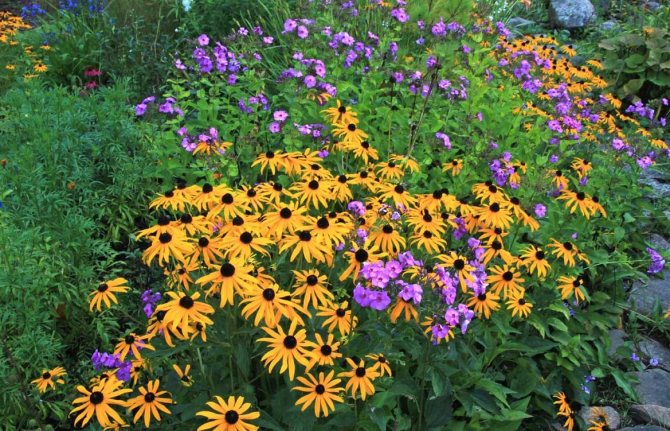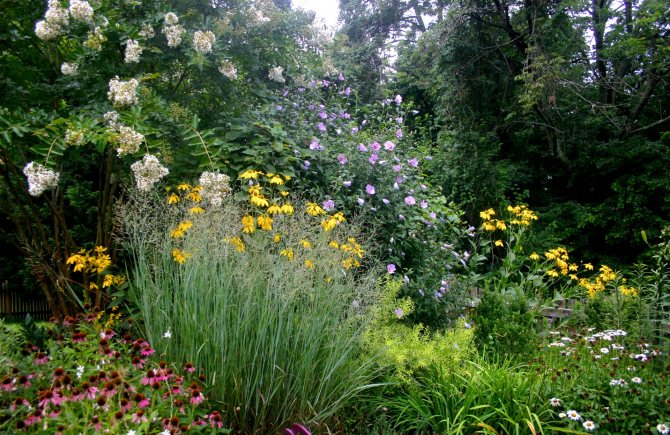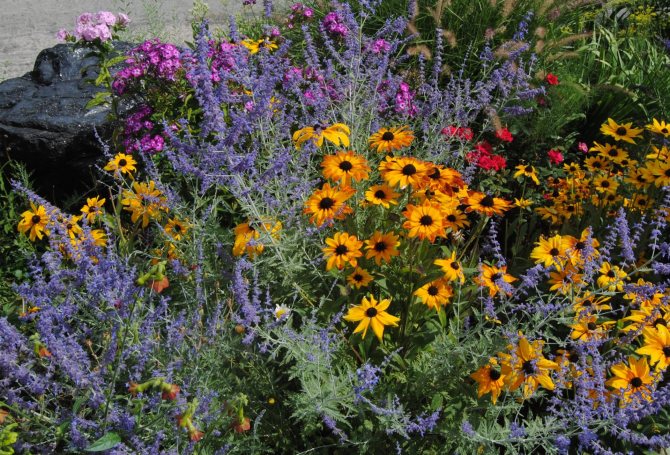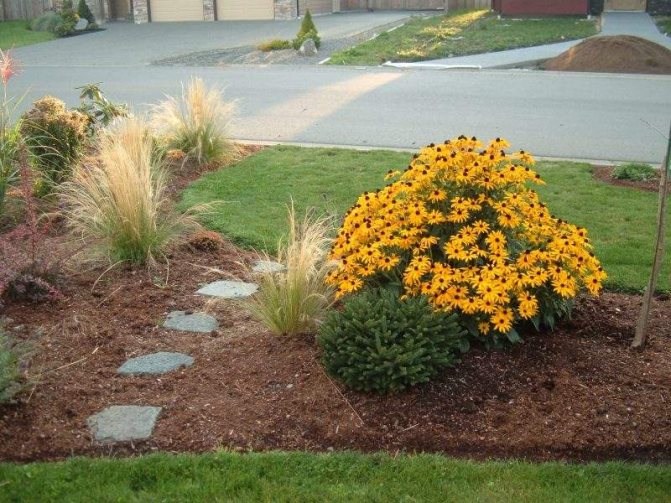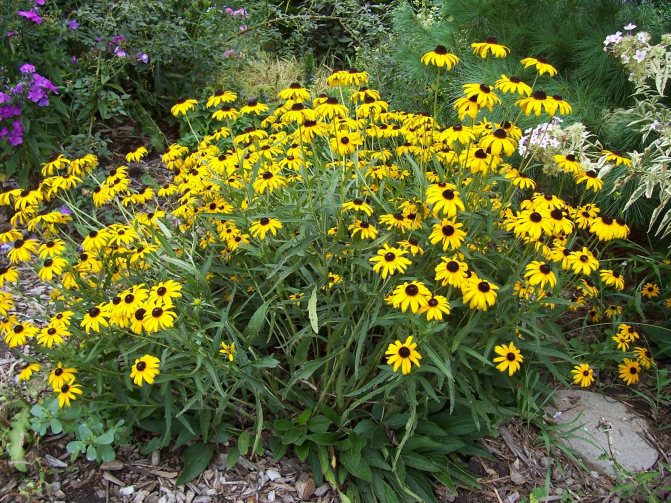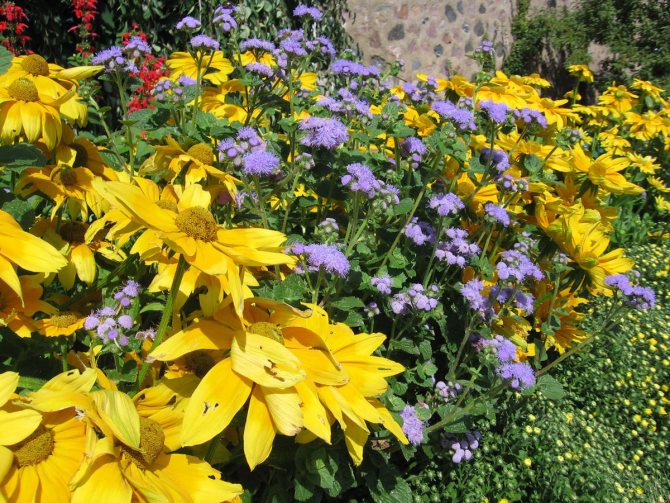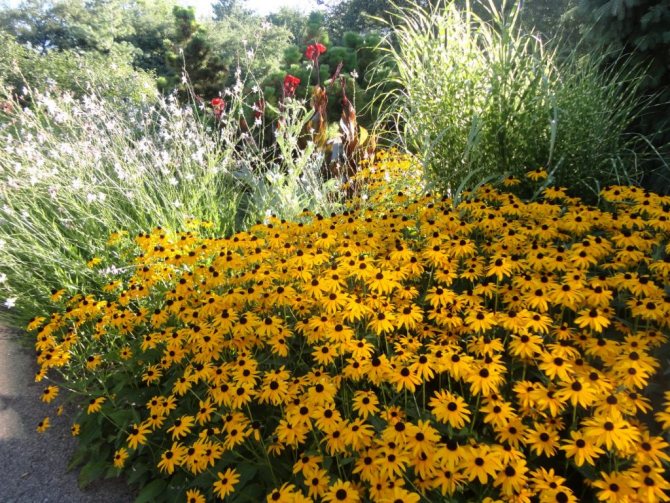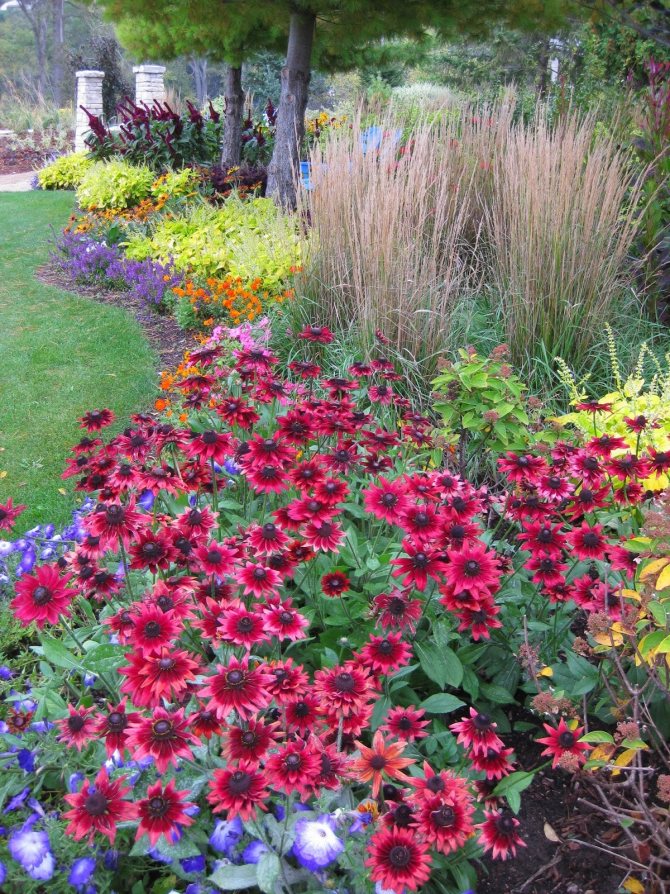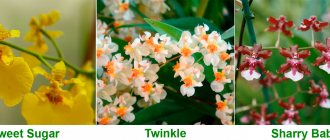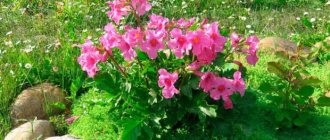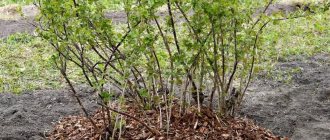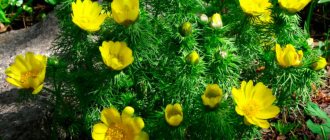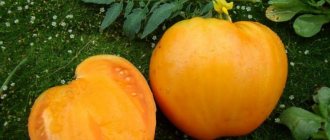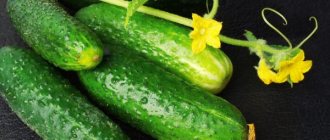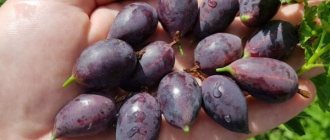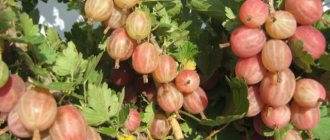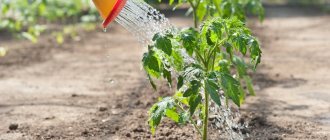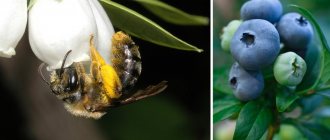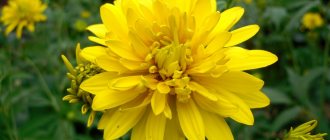Description
Rudbeckia is a flowering plant of the Aster family, native to North America, has 40 species and several hundred varieties. It happens perennial and annual.
Most often, rudbeckia has yellow petals with a lush convex center. The flower is unpretentious, does not require regular maintenance, which is especially attractive for novice gardeners. Due to the abundant and prolonged flowering, rudbeckia turns the meadow into a solid yellow-orange lake. The people are called "sun hat" and "black-eyed Suzanne."
Species diversity of rudbeckia
Rudbeckia has a huge number of species and varieties, if you describe each of them, you can write a book. In this article, we will briefly describe the most popular.
Embracing
This annual species reaches a height of 80 cm. Leaves are oval or elongated with a pointed apex and a thin jagged edge.
The petals are yellow or brown-orange, drooping down, as if they grab the stem, hence the name. The center of the flower is dark, 2 centimeters above the petals.
Hairy
Biennial decorative flowers. The length of the stems reaches up to 1 meter, less often - 50 cm.
Shoots and oval leaves are covered with villi. Straight or branched stems. The diameter of the flowers is up to 10 cm, the color is yellow, sometimes with an orange tint. Large dark red center. Abundant flowering, from July to frost.
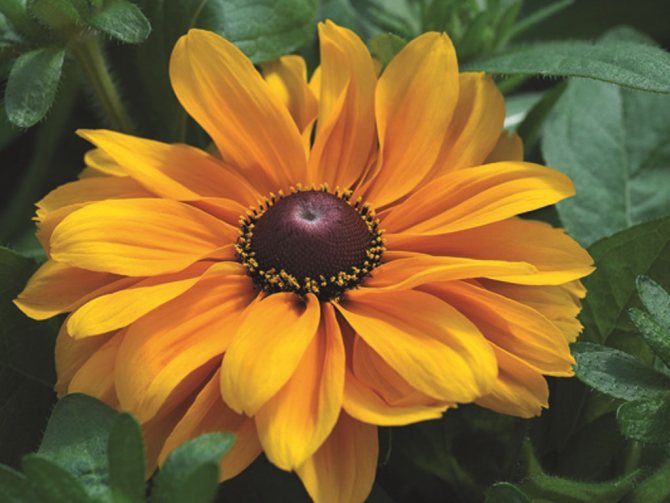
Rudbeckia hairy.
Dissected
Quite a tall kind of rudbeckia - it sometimes stretches up to two meters. Stems are straight, rigid, covered with pinnately-divided leaves. In the inflorescence there are 1-3 rows of bright yellow flowers up to 10 cm in diameter.
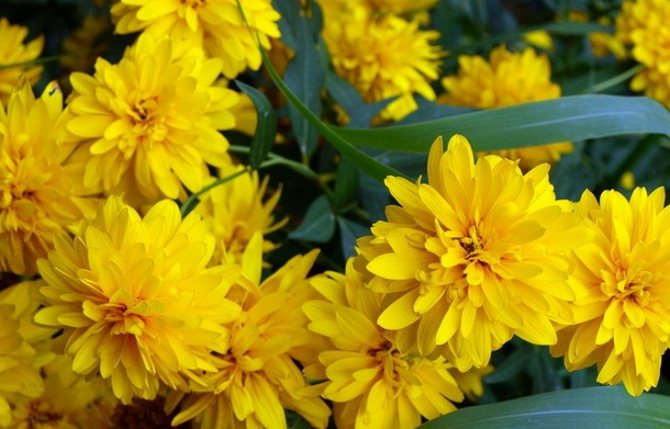

Rudbeckia dissected.
Glossy
This perennial stretches up to two meters in height. Leaves are oval, elongated, with a slight sheen. The flowers are large, up to 12-15 centimeters in diameter, with rich yellow elongated flower petals and a convex green center. They bloom from mid-summer to mid or late autumn, depending on the climate. With the first frost, flowering stops.
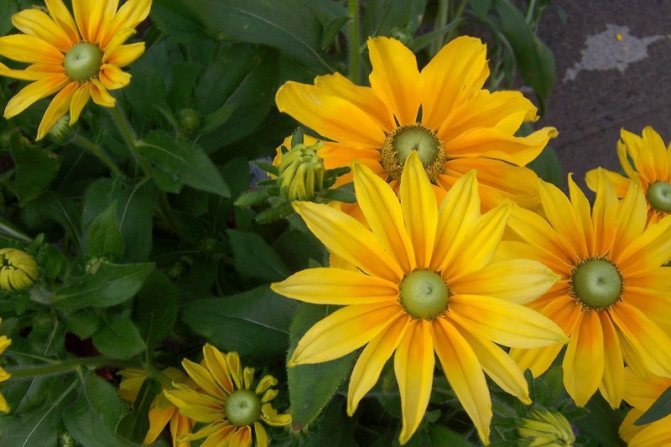

Rudbeckia is glossy.
General information about rudbeckia
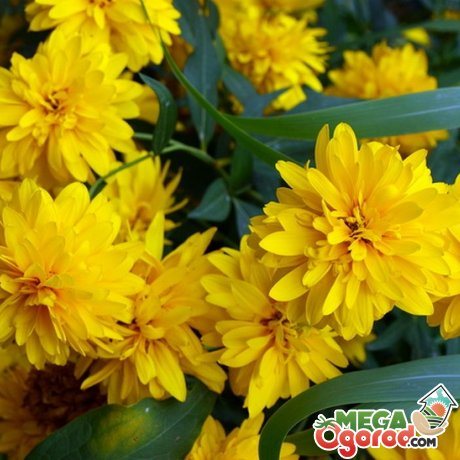

Rudbeckia belongs to the Aster family. This is an unpretentious plant. There are both annual and perennial representatives. Rudbeckia can often be seen both in decorative landscape compositions and in ordinary summer cottages of the European and Asian zones. However, its homeland is North America, it was from these distant lands that sunny and bright flowers arrived in the 16th century.
Rudbeckia has erect stems with dense foliage, their height ranges from 50 cm to 2 meters, depending on the species.
The flowers are inflorescences from 5 to 15 cm, they are yellow, orange, golden, purple or pink in color. Leaves are oblong, can be whole or split.
Varieties
Cappuccino
Plant height 40-50 cm, on one rosette from 6 to 8 peduncles, flowers up to 20 cm in diameter. Maroon centers are framed with two-color petals hanging down to a fluffy stem. The flower petals are coffee-colored in the center and reddish or yellow at the tips.
Suitable for cutting, flowering lasts 30 to 35 days.
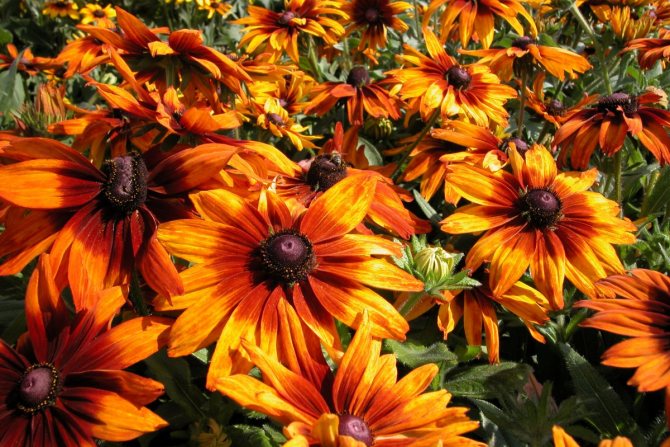

Rudbeckia cappuccino.
Marmalade
A favorite variety not only for summer residents, but also for landscape designers. Reminiscent of yellow chamomile and echinacea.Blooms late, but flowering is long and continuous, up to frost. Suitable for cutting into bouquets. It grows up to 60 cm, but if planted densely, it can grow.
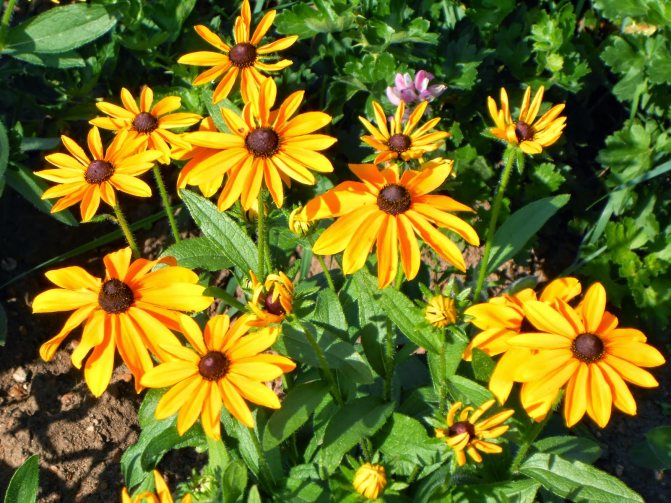

Rudbeckia marmalade.
Moreno
A popular variety with straight, branched stems up to 70 centimeters long. The leaves are oval, the lower ones are on long petioles, the upper ones are sessile. Inflorescences up to 15 cm in diameter, petals are yellow, orange or brown, the center is tubular, purple-black or brown. The variety belongs to the hairy species.
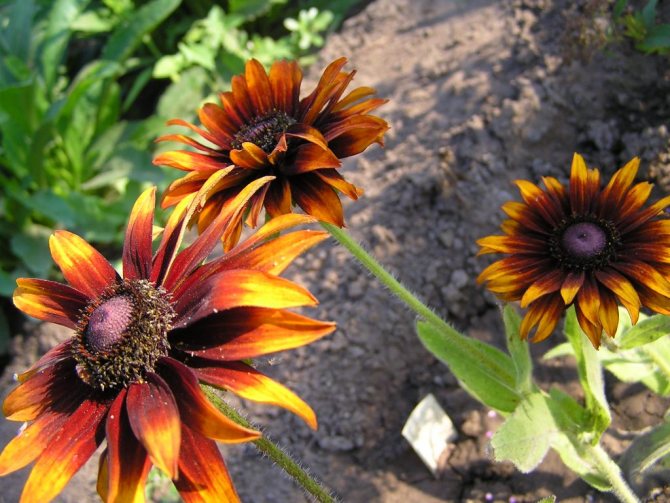

Rudbeckia moreno.
Amber
Rudbeckia Amber is especially decorative. Its yellow-gold petals at the edges and dark purple in the center give the garden a color and a sense of luxury. They reach a height of 60 cm, flowers up to 10 cm in diameter. They bloom for almost two months, from late June to mid-September.
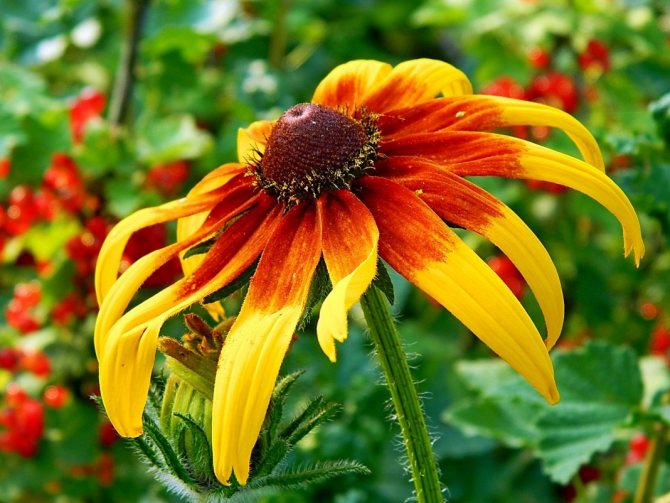

Rudbeckia amber.
Golden ball
The most popular variety. This is a double inflorescence of tubular greenish and bright yellow marginal flowers. It looks spectacular in the sun, so it's better to choose an open place for it.
In May, the bushes stretch under 2 meters, so it looks decorative even before flowering. Flowers form in early summer, and in two weeks the bush is covered with golden flower balls and pleases the eye with sunny bloom until the end of summer.
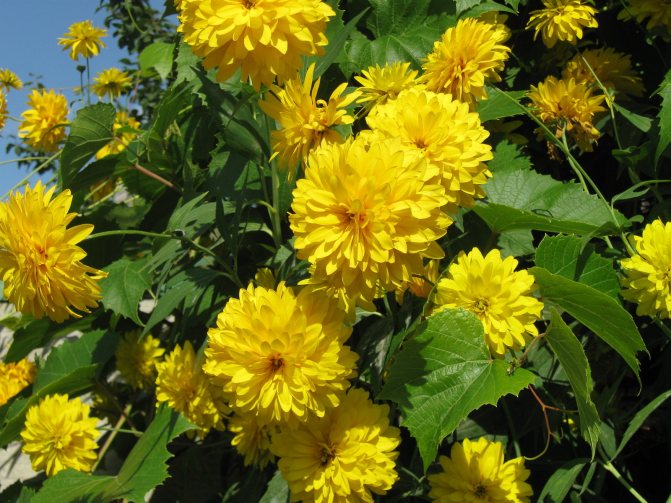

Rudbeckia golden ball.
Purple
Stem length up to a meter in height, flowers 10-12 cm. Suitable for cutting for a bouquet, blooms from July to September.
This variety is most often confused with echinacea. But these are completely different plants, and here are their main differences:
| Differences | Rudbeckia | Echinacea |
| Petals | brownish purple | crimson |
| Bracts | soft, thornless | tough, prickly, pointed |
| Drought tolerance | excellent | average |
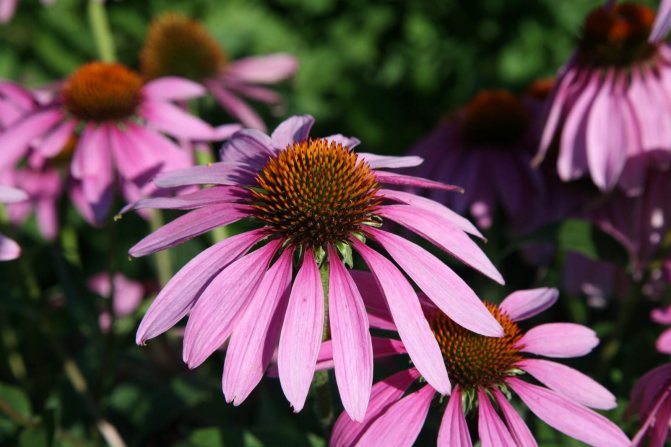

Rudbeckia purple.
Seedling method
Let us consider in more detail the features of growing rudbeckia from seeds using a seedling method.
Sowing
Rudbeckia seeds are sown for seedlings in March, sometimes at the end of February. It is recommended to place one or two seeds in one container. But if the container is large, mass planting is also acceptable. The substrate must be nutritious and moisturized. Top seeds are sprinkled with soil a little.
How to care for seedlings
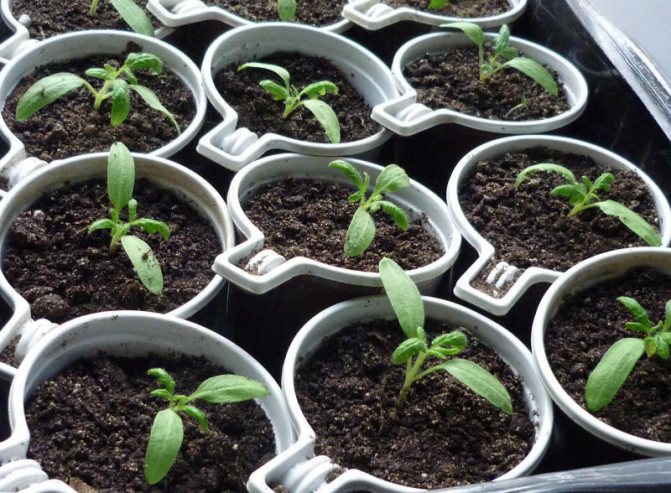

Watering of seedlings is carried out from a spray bottle, since the seedlings of rudbeckia are very fragile. Use water only at room temperature and separated. Waterlogging is unacceptable, it can even lead to a dangerous fungal infection.
In order for the seedlings to develop safely, maintain the indoor temperature at +22 degrees. If it is cool, the seedlings will slow down the rate of their development. In extreme heat, weak, threadlike sprouts are obtained.
If the sowing was massive, the seedlings will have to dive. This procedure is performed at the stage of formation of two or three leaves. Remove only the weakest shoots, and plant the strong and healthy in separate cups.
Preparing for landing
In order for the rudbeckia seedlings to be ready for planting in open ground, it is recommended to harden them first. It is better to start hardening at the beginning of May, so that by about the 20th, the seedlings are already ready for planting.
How to plant in open ground
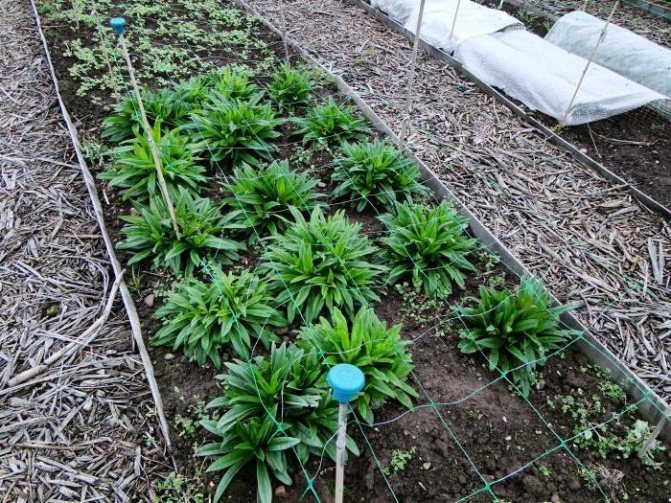

Transplant the cups into the garden bed when night temperatures stop dropping below freezing. Planting is done in separate holes, keep a distance between the bushes of 50-60 cm.
If the weather is already warm, the seedlings will take root faster. If it is still cool, it is better to cover the bed at night with film or agrofibre before the onset of fine days.
Rudbeckia from seeds. Growing rules
Annual rudbeckia is grown only from seeds. If the weather permits, then it is possible to go straight into the ground, but since the sowing is done at the beginning of April, for some regions it is still a cold time, the ground is still frozen after winter.
In peat or plastic cups, or in a greenhouse, soil heated with warm water is poured (cold earth harms the seeds).Rudbeckia seeds are lowered to a depth of 3 mm and sprinkled with a thin layer of earth. Watering immediately after sowing is not required, you can spray with water. It is important to protect crops from cooling, for this you should cover them with a film or glass, try to maintain a temperature of + 20 ° - + 22 °. You should also regularly remove condensation from the cover and spray the crops.
Seedlings appear in two weeks. Rearrange the seedlings with the first shoots in a sunny place and remove the protective covering. Now you need to regularly water the young rudbeckia. 2 weeks before transferring the seedlings to the open ground, start hardening the plant. Take flowers outdoors every day, gradually increasing the time it is outside.
Care rules
Bright yellow bushes can be found in almost every flower garden. You just need to know some of the features of growing this spectacular plant. What kind?
Rudbeckia planting
There is a place for these sunny flowers in any garden area! It is not surprising that they love the sun, but they also thrive in partial shade. Deprived of sunlight, unpretentious rudbeckia will also bloom, but over time they will lose their decorative effect. Most of them, although they look stable, can lie down after the wind, or heavy rain, therefore, if the wind often "walks" in your area, find a place near the fence, or provide a support.
When choosing a place for planting rudbeckia, keep in mind that it grows very quickly and occupies the territory. Therefore, it is best to give her a separate place in the flower bed next to the bulbous primroses, which she will cover with her foliage, or next to the lush bushes that will compete with this "fidget". For example, hydrangea, or roses.
Perennial rudbeckia reproduces by dividing plantings in spring, when leaves appear on the surface, or in autumn after flowering. The plant is easy to transplant, quickly adapts to new conditions and does not even lose its decorative effect.
Rudbeckia is easy to grow from seeds that remain viable for three years. It is better to plant them in the ground in early May, when warm weather sets in. The soil for planting can be dug up in advance with compost soil. Like all flowers, rudbeckia prefers fertile loose soil, but for lack of choice, it grows even on poor soils. However, plants easily reproduce by self-sowing, you just need to rely on nature and thin out the seedlings in the spring.


Rudbeckia care
Despite its love for the sun, rudbeckia does not tolerate drought! Therefore, caring for it involves regular watering during the summer heat so that the bushes do not look lethargic. You can mulch the plantings with straw to keep the soil moist for longer.
Rudbeckia flowers multiply rapidly, therefore they very quickly begin to interfere with themselves: they stop blooming, or lose their decorative effect. To prevent this from happening, plantings are thinned out every 4-5 years, planting bushes. Non-flowering plants can be relocated to another area, thus updating the planting and freeing up space in the flower bed.
For newly planted rudbeck, compost added to the soil during planting will serve as top dressing. Organics for flowers: types and applications. It is enough to fertilize perennial bushes three times per season: in the spring with the beginning of growth (with an emphasis on the nitrogen component), during the flowering period (the phosphorus component is important) and on the eve of wintering (potassium is needed). You can use complex mineral mixtures for flowering crops, but not more often than once a month from May to September. Excess fertilizer damages the plant and can burn the delicate root system!
To make the bushes look neat, it is better to remove dried flowers. In case you want to collect the seeds, they should be left until autumn, when the seed pod is ripe, and they will be easily separated. Perennial rudbeckia successfully winters in the middle zone.On the eve of wintering, it is advised to cut off the entire aerial part, but it is better to leave it to dry out so that it serves as a natural shelter for plants. If frosty and snowless winters are frequent in your area, cover the bushes with mulch, which can be distributed around the plantings in spring. Details about the types of mulch.
Planting in the ground and caring for plants
Hardened plants, without disturbing the earthy coma, are planted in small holes at a distance of 30 cm from each other. In clear and warm weather, the plants will take root well, and on unfavorable days at night, the rudbeckia should be covered with spunbond or lutrasil. After planting, you need to tamp and water the soil, mulch up to 8 cm. Compost, sawdust, any weeds and leaves, as well as manure are suitable as mulch.
Caring for rudbeckia is not difficult - it only needs moderate watering, loosening and removing weeds next to young plants. High grades need to be tied up so that they do not break from the wind.
Site selection and soil preparation
Rudbeckia is generally not capricious in the choice of soil, prefers clay and does not feel very comfortable in the sand. She loves bright light, so they choose sunny or slightly shaded places for her. Before planting rudbeckia, the earth must be dug up, sand and crushed stone must be added to heavy and clayey soils, chalk or dolomite flour to acidic soils. In addition, you can increase the fertility of the soil with compost.
How and what to water plants
Drought is harmful to Rudbeckia, without water it withers, flowers lose their shape, and over-watering threatens with putrefactive diseases. Therefore, you need to carefully monitor watering - moderation of humidity is very important. It is useful to water the rudbeckia at the same time - in the morning or in the evening.
Fertilization
Rudbeckia loves mineral fertilizers in early spring, and at the end of May, if the soil is infertile, it will be useful to add a mixture of nitrophoska with potassium sulfate. In summer, the bushes are fed with manure solution.
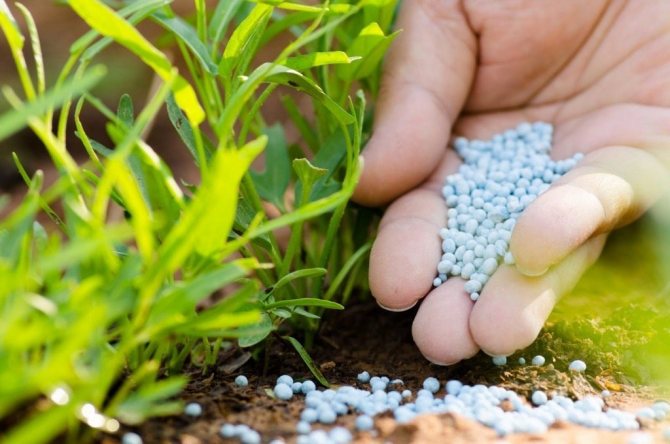

What time to transplant
Only perennial rudbeckia is transplanted every 3-5 years in the spring, when the soil warms up.
Does it need pruning
Dried flowers should be removed. To prolong flowering and prevent self-seeding in autumn, when the flowers begin to wilt, the inflorescences are cut to the first leaf. When the remaining part dries, it is cut off at the root.
How to prepare flowers for winter
To prevent the roots from freezing in central Russia and the northern regions, the soil is covered with foliage, dry grass or branches of conifers. In winter, a layer of snow is poured onto the flower bed. In the south, the plant will survive the winter without shelter.
Difficulties in growing rudbeckia
Despite its unpretentiousness, rudbeckia is still a living plant, and needs at least minimal care, which includes regular moderate watering, swelling of the soil. It does not require fertilizers, but with them the flowering will be more magnificent and abundant. It is also advisable to weed the beds, as the weeds absorb nutrients.
Of the minuses - most varieties are not cut to create bouquets and flower arrangements, rudbeckia is suitable only for growing in the garden.
Growing features
Rudbeckia will not cause much trouble - this is a godsend for novice gardeners. On fertile soil, the plant blooms more abundantly, but with smaller inflorescences. A little compost can be added to the depleted substrate, and the clay soil can be improved by adding sand. The plant prefers places with good lighting, especially annuals. Perennial species will withstand partial shade, however, the petals will be slightly paler.
Caring for rudbeckia consists in regular watering, especially on hot days, since the flower baskets will droop if there is a lack of moisture. Loosen the soil around the bush occasionally, especially if you don't want to allow self-seeding. Remove wilted inflorescences so that the flowering is longer and lush. Fertilizing with mineral fertilizers is needed during the period of active growth and during the formation of buds.
The culture is resistant to diseases.Sometimes it suffers from nematodes, but in this case, insecticide treatment will help. At the end of autumn, the plantings are cut off at the root and a shelter is built from dry grass, foliage, spruce branches. In general, the crop tolerates frost well, but insurance does not hurt.
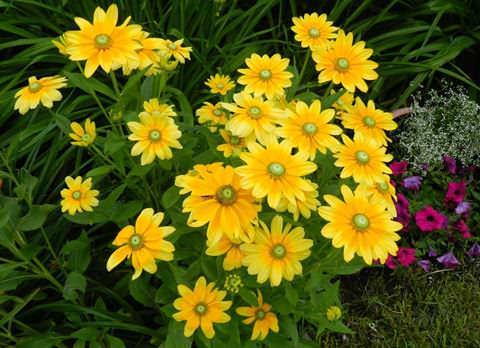

Diseases and pests
Rudbeckia rarely gets sick, parasites do not overpower it. The only thing that rudbeckia can get sick with is powdery mildew. It looks like a white-gray bloom on the leaves. Treatment consists in spraying with copper sulfate or colloidal sulfur solution. Sometimes diseased shoots are cut off so that the infection does not spread, and the plant is also treated with sulfur-based solutions.
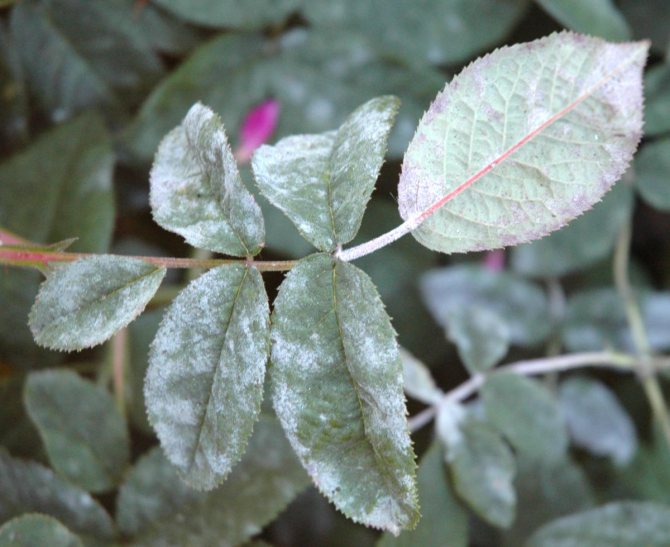

Powdery mildew.
Of the parasites, rudbeckia can be susceptible to nematodes. In this case, it is isolated from other plants and treated with special formulations from parasites.
Rudbeckia in landscape design
For decorative purposes, rudbeckia is grown on a balcony, terrace, along fences, in the background of a decorative area, where garters behind other flowers are not visible. Combines with asters, chrysanthemums, spur, gailardia. Lilac small flowers of annual verbena look great with bright yellow rudbeckia. In the background, any tall flowers with large inflorescences, as well as ornamental grasses and creeping plants, will do.
When developing a design, it should be borne in mind that rudbeckia grows strongly, so it needs to be left with enough space.
If you have a large space for garden decoration, then an interesting solution would be to densely plant a meadow with rudbeckia. A kind of sunny island will grow, which will delight the eye from June to late autumn, attracting colorful butterflies. A great place to top up Instagram.
When to transplant rudbeckia
After 3-5 years of growth in one place, the plant needs to be thinned, otherwise decorative properties decrease, flowers become smaller, there is not enough space for new bushes to develop. Self-seeding gives a lot of unnecessary daughter shrubs, so it is better to keep the flower bed in its original form, providing the necessary conditions for development.
An adult bush is transplanted to a new location in early spring or late summer.when there is no active vegetation. It is advisable to divide the bush to give new room for plant growth. This will turn on the regenerative mode, and the flowering will be more abundant.

